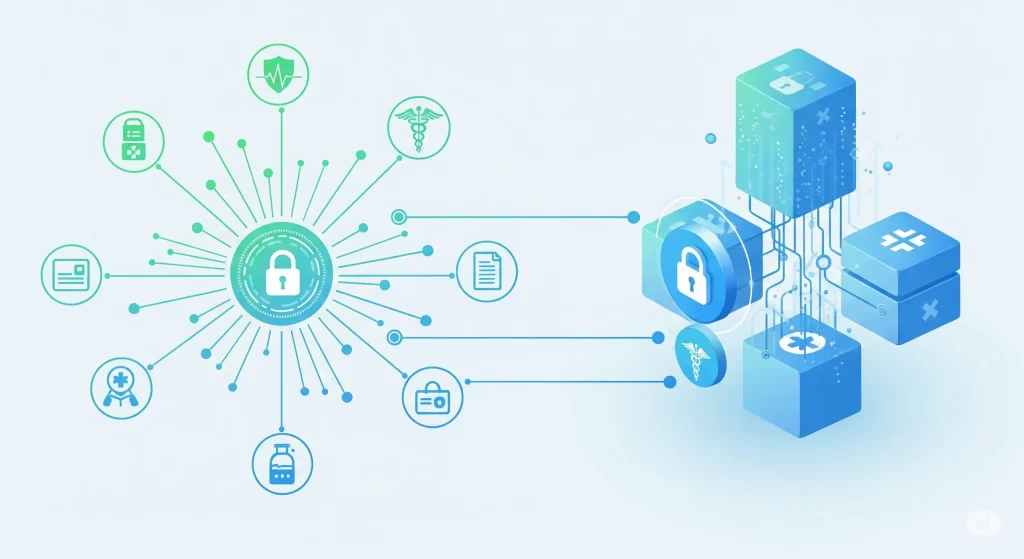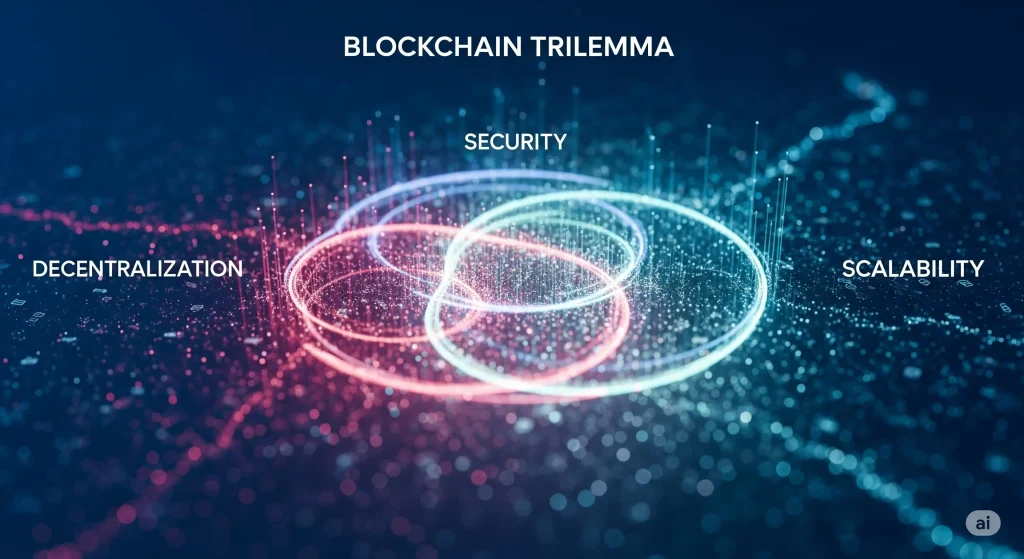Dive into Blockchain’s Transformative Power for Trust, Data Privacy & Business Innovation. Explore Enterprise Platforms, Healthcare Integration, Digital Marketing Impact, and Scaling Solutions for a secure Digital Future in the USA.
Blockchain is no longer just a Buzzword; it’s a Foundational Technology that Promises to Redefine Trust, Efficiency, and Security across Virtually Every Sector. By understanding its Core Principles and Diverse Applications, Individuals and Businesses in the USA and Globally can Strategically Leverage its Power to Build a More Transparent, Secure, and Innovative Future. Embracing this Shift is not just about Staying Competitive; it’s about Unlocking Unprecedented Opportunities in the Smart Digital Age.
How Does Blockchain Support Data Privacy and Decentralization?

Blockchain Intrinsically Supports Decentralization by distributing Data across a Network of Nodes, removing Reliance on a Single Central Authority. This Enhances Data Privacy by Eliminating a Single Point of Attack for Large-Scale Data Breaches. While Public Blockchains offer Transparency, Privacy is Achieved Through:
- Pseudonymity: Transactions are linked to Cryptographic Addresses, not directly to Personal Identities, Offering a Layer of Privacy.
- Encryption: Data Stored on or Referenced by the Blockchain can be Encrypted, with access Controlled Via Private Keys.
- Zero-Knowledge Proofs (ZKPs): Advanced Cryptographic Techniques allow One Party to prove they possess certain Information without Revealing the Information Itself, Enabling Verification without exposing Sensitive Data.
- Private/Permissioned Blockchains: These Networks allow Businesses to Control who participates and what Data is Visible to maintain Confidentiality while still Leveraging Blockchain’s Benefits.
What Are the Best Blockchain Platforms for Enterprise Solutions?

For Enterprise Solutions, Scalability, Privacy, and Permissioning are often Critical. Leading Platforms Include:
- Hyperledger Fabric: An Open-Source, Permissioned Blockchain Framework Hosted by the Linux Foundation, Ideal for Building Private Business Networks with Modular Architecture.
- R3 Corda: Designed Specifically for Financial Services, it’s a permissioned distributed Ledger Technology focused on Privacy and Interoperability between Institutions.
- Enterprise Ethereum (e.g., Quorum, Besu): Leveraging the Power of Ethereum but adapted for Enterprise Needs, Offering Private Transactions and Permissioned Access while Retaining Smart Contract Capabilities.
- IBM Blockchain: Often built on Hyperledger Fabric, Offering managed Blockchain Services for Various Industries.
- XDC Network: A Hybrid Blockchain (Combining Public and Private Elements) designed for Global Trade and Finance, Emphasizing Speed and Low Transaction Costs.
How Does Blockchain Technology Impact Digital Marketing or SEO?

Blockchain’s Impact on Digital Marketing and SEO is Emerging, Primarily through:
Enhanced Data Privacy & Control: Empowering users with More Control Over their Data, Leading to a Shift from Third-Party Cookies to More Consent-Driven Data Models. Marketers need to adapt to building Trust Directly with Consumers.
Reduced Ad Fraud: Providing Transparent and Auditable Records of Ad Impressions and Clicks, Mitigating Fraudulent Activities in Programmatic Advertising.
Verified Authenticity: Ensuring the Authenticity of Content, Reviews, and Digital Assets, Combating Misinformation and Deepfakes.
Decentralized Advertising: Potential for Peer-to-Peer Advertising Platforms, Cutting Out Intermediaries and giving Advertisers and Publishers More Direct Value.
Loyalty Programs: Creating More Engaging and Transferable Loyalty Points as Digital Tokens.
SEO Implications: While direct SEO changes are Minimal, the Emphasis on E-E-A-T (Experience, Expertise, Authoritativeness, Trustworthiness) aligns perfectly with Blockchain’s Core Principles. Content from Blockchain-Verified Sources or About Verified Entities could gain Higher Trust Signals. The Ability to Verify the Origin and Integrity of Content could become a Ranking Factor in the Long Term.
How Can Blockchain Be Integrated into Healthcare Systems Securely?

Integrating Blockchain into Healthcare Systems Securely Involves leveraging its Strengths while addressing Privacy Concerns:
Patient Consent Management: Blockchain can record and Manage Patient Consent for Data Sharing, allowing Patients Fine-Grained Control Over who accesses their Medical Records.
Immutable Patient Records: Encrypted Patient Data (or its Hashes) can be stored on a Blockchain, Creating an Unchangeable Audit Trail of All Access and Modifications.
Supply Chain for Pharmaceuticals: Tracking Drugs from Manufacturing to Patient, Combating Counterfeiting and Ensuring Drug Authenticity.
Provider Credentialing: Verifying Medical Professionals’ Licenses and Credentials in a Tamper-Proof Manner.
Secure Data Sharing: Using Private or Permissioned Blockchains, Healthcare Providers can Securely Share Relevant Patient Data with Authorized Specialists or Institutions while Maintaining Privacy.
Medical Research: Facilitating Secure and Anonymous sharing of Aggregated Patient Data for Research, Accelerating Discoveries.
What Are the Challenges of Scaling Blockchain Networks?

Scaling Blockchain Networks to handle Enterprise-Level Transaction Volumes while maintaining Decentralization and Security is a Significant Challenge, Often Referred to as the “Blockchain Trilemma.” Key Challenges Include:
- Transaction Throughput: Public Blockchains like Bitcoin and Ethereum (pre-ETH 2.0) have limited Transactions Per Second (TPS) compared to Centralized Systems like Visa.
- Network Latency: As Networks Grow, the Time it takes for Information to Propagate across All Nodes can Increase.
- Storage Limitations: Every Full Node Stores a Copy of the Entire Blockchain, which can become Enormous, Deterring New Participants from Running Full Nodes and Impacting Decentralization.
- Energy Consumption: Proof of Work (PoW) Consensus Mechanisms Consume Vast Amounts of Energy, Posing Environmental Concerns.
Solutions being Explored and Implemented include:
- Layer 2 Solutions: Off-Chain Scaling Solutions like Lightning Network (for Bitcoin) or Rollups (for Ethereum) process Transactions Off the Main Chain and then Settle them on the Main Chain.
- Sharding: Dividing the Blockchain into Smaller, Interconnected “Shards” that can process Transactions in Parallel.
- Alternative Consensus Mechanisms: Moving from PoW to More Energy-Efficient Mechanisms like Proof of Stake (PoS) or Delegated Proof of Stake (DPoS).
- Optimized Block Sizes & Data Compression: Adjusting Block Parameters to Fit More Transactions or reducing Data Size.
